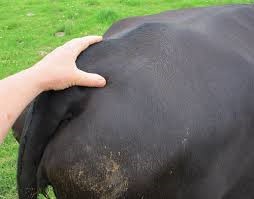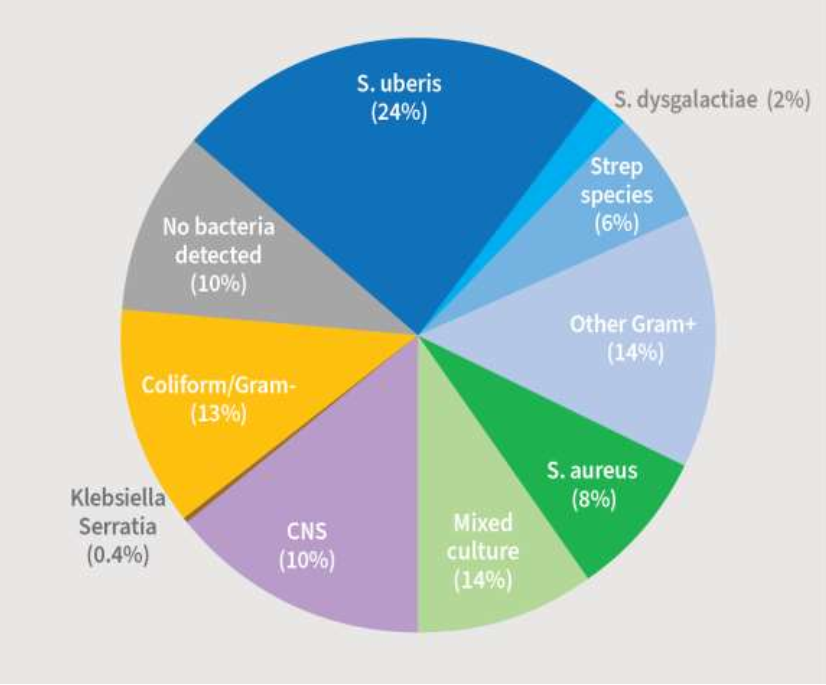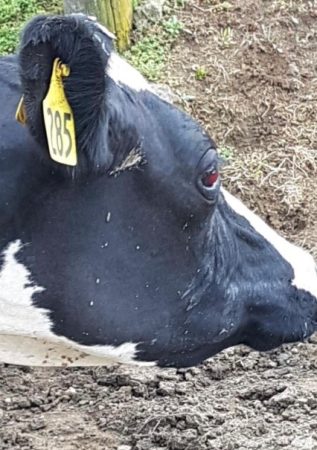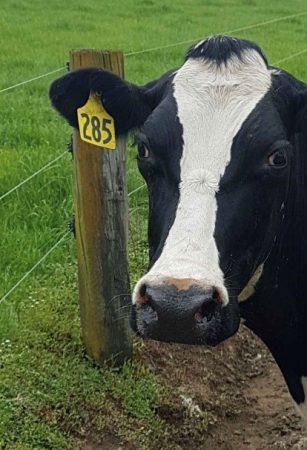FARMER
FOCUS
Welcome to our September newsletter!
Aaand it’s September! Daylight savings is fast approaching along with more sunlight hours (we hope!) We’re well aware it’s still a very busy time on farm; the gap between calving and mating seems shorter and shorter each year. If you need to book in for those non-cyclers give us a call early so we can make sure to have availability that fits in with your planned start of mating dates- premating tail paint should be on by now.
For our winter milkers- we’re coming up on preg testing time. Remember if you’re wanting gestational aging done we can only accurately age a fetus between 6 and 13 weeks. Have a look at your AI and bull dates to see about timing. Alternatively give us a call and we can work it out together to make sure we don’t miss the boat by testing too late! As always, we hope you’re all keeping well?

6 Tips for Success: Mating Momentum
Calving is slowing down, the grass is growing and for those not already started, mating will be upon us before we know it. Is your cow health plan in place for mating? Here are a few tips:
Cow condition Try to keep body condition score (BCS) loss between calving and mating to less than 1 BCS. With mating on the doorstep there is only time to tweak things now so BCS the herd and preferentially manage any cows below BCS 4.
Non-cyclers Monitoring pre-mating heats is invaluable for identifying potential non-cyclers early.
Monitor BVD Infection from BVD can have devastating impacts on your herd’s reproductive performance over mating, let alone the year-round production and health impacts that can come with it. Make sure your herd is BVD free; monitor your bulk tank milk and take action to eradicate persistently infected animals if present.
Prevent BVD Don’t just monitor – prevent it! Vaccinate stock if you can but remember the other strategies such as farm biosecurity and testing bought-in animals (i.e. service bulls) too.
Seek advice early Make an appointment with a farm vet early and get that mating strategy in place. Cover cow health and BCS in the lead up to mating as well as how to manage the mating period to get the results you want.
Team talk time Get your team on board with what’s coming up over the next few months. Explain to them what you are trying to achieve, why, their part in it and how you want things done. That way, they’ll know what’s coming up next and the jobs to do.
Source – 6 Week Challenge – LIC

Mating Success
With mating nearly upon us, that needs to be the major focus for the next 12 weeks.
By now you should have the cows tail-painted and be recording the number of cows, and their IDs, as they come on heat. You need to have at least 80% of the herd cycling by the start of mating. For a 300 cow herd that is 12 cows a day every day from now until mating starts. (i.e. 4 cows/day/100 cows in herd) The further behind on that target your herd is, the more aggressively you will need to treat it.
If you go once a day for the lighter cows to get them cycling, that should have happened by now – a couple of weeks before mating is too late to have good results.
When treating non-cyclers, early treatment is most profitable. By early, we mean one week before mating start. The later after that you treat, the less profitable it becomes.
Who to treat: Cows calved 40 days but not yet cycled (50 days for heifers). If needing to treat aggressively (ie way behind on cows coming on each day) then treatment 28 days post-calving is about as early as you can go.
Trace Elements: If not already done check particularly copper, selenium, and magnesium levels ASAP, as copper injection, in particular, may depress conception rates if done too close to mating start.
Heat Detection: Good heat detection is critical for good mating performance – ensure your heat detectors know what they are doing – a training session out in the paddock well before mating starts is well worth the time. The InCalf Book, and Dairy NZ web site have good heat detection training resources for experienced farmers to refresh their skills, and for training new staff. Don’t forget to train on recording systems too – information is power!

Mastitis
With the payout going south, this season, more than most, it will be critical to get maximum production from every cow.
Bulk Somatic Cell Count:
Mastitis can be a significant, but not obvious, cause of lost production. Research has shown that there is a 23% decrease in production for every doubling of somatic cell count over 100,000.
At a $7.50 payout getting your cell count down to 100,000 could increase your income by up to $21,500. This does not include the cost of treating clinical mastitis cases.
Your Fonterra Farm Insights Report will quantify this for your farm, and show you where you sit compared to other suppliers in your district.
Clinical Mastitis:
Mastitis is a painful condition. Treatment is time consuming at a very busy time of year. Labour, drugs and discarded milk, along with increased culling, are costing you $150 per clinical case.
Reducing bulk cell count and clinical mastitis cases is worth a lot of money, through increased income and fewer overhead costs. The SmartSAMM gap calculator can quantify this loss for your farm.
Mastitis; The causes:
Early in my career I attended a farmer seminar run by an American mastitis researcher called Woody Pankey. What I remember most (the ONLY thing apart from his name!) from his seminar:
” There are only four ways a cow can get mastitis….left front( teat), right front , left rear, right rear ”
While treating clinical mastitis is important, it is the ambulance at the bottom of the cliff. The key to solving a mastitis problem is to find out how the bacteria are getting in, and stop that.
The Dairy NZ Healthy Udder Guide is a good resource to look at. Mastitis is a result of the interaction between environment, cow, farmer and milking machine. Mud and muck from the environment contaminating the teats are the main source of environmental infections, mainly Strep. Uberis. Contagious mastitis, mainly due to Staph. Aureus, is caused by bacteria on the cow being spread via the cups or milkers during milking. NB: Milk from an infected cow can spread infection to the next FIVE cows that use that set of cups.
Cow teat condition will give you clues as to what is causing mastitis. – Is the teat end damaged? The skin dry, cracked or scaled. After Cup Removal 90%+ of teats should be soft and supple, 80%+ of teat ends should be smooth and 100% should have full coverage with teat spray.
We can help with your mastitis problems. Jamie, Sarah and I have all done the Advanced Mastitis course for Vets. We are well equipped to help you solve your mastitis issues!
THE CAUSES OF MASTITIS:
While strep and staph make up the majority of cases, an increasing number are caused by bacteria such as Klebsiella and Serratia species which do not respond to treatment. Also of note 10% of “mastitis” cows do not have a bacterial infection.
Historically – mainly due to lack of timely information – we have treated a mastitis cow with our “first line” drug, and waited to see if it worked. We have all, unknowingly, treated 10% of ‘mastitis’ cows that are no longer infected – or never were, and 10% with CNS, which does not require treatment.
Cows with Serratia or Klebsiella mastitis – neither of which respond to treatment – have been treated, wasting time and drugs.
The on-farm technology now exists to get rapid overnight results to identify the bacteria concerned, and their sensitivities to common mastitis treatments.
With the growing issues around antimicrobial resistance and antibiotic use, this allows the farmer to treat every cow with the appropriate antibiotic and tells us which cows are NOT infected, therefore not requiring antibiotics at all.
Scott MacDougal and others have done research to show that if you detect a mastitis cow, take a milk sample before treatment, and give her antiinflamatory drugs (Ketomax, Metacam) and begin antibiotic treatment the following day, the results are the same as if you had started treatment at the time of first detection.
The technology is the Mast-A-Test machine – a grey box into which you put a test card of culture medium and antibiotic sensitivity tests, and your milk sample(s). It can handle two samples at a time, and gives a result within 24 hours. This is e-mailed to you, and your vet or advisor to enable treatment with correct antibiotic – or no antibiotic – 24 hours after detection
Word search- vet style.
It’s not often I am lost for words, but as most of you know occasionally I am lost for the right word to describe an unusual clinical sign.
One sunny day in the thick of calving I got a call from Farmer Joe who said ‘Sarah, I’ve never seen anything like this before- my cow has blood in her eyes’. Now, to my mind that meant cow 285 was bleeding from her conjunctiva (the membranes around her eye) and this could possibly mean cancer eye; strange to happen in both eyes though! I could not have been more wrong! Farmer Joe sent me photos and there was, indeed, blood inside this cows eyes! I decided it was best we visit cow 285, having NEVER seen or heard of anything like this before. I wanted to make sure there weren’t any other alarming clinical signs. And there weren’t. Cow 285 was apparently blind (not surprising considering the blood) but all ocular reflexes and all other vital signs were within normal limits. Farmer Joe and I joked that we never stop learning in our respective jobs and that the best we could do was to treat what could be treated. I gave some anti-inflammatories and asked farmer Joe to keep me informed of her progress while I went home to research this strange phenomena. Farmer Joe let me know a couple of days later that the cow’s sight had returned and she was marching herself to the shed each morning as normal! In turn, I advised him that the name of this clinical sign is hyphema and it is just a random thing that happens sometimes. So, all’s well that ends well and we have a new piece of information for crosswords and quiz nights!
PS- if you do spot this sign in one of your cows- best to get her checked out in case there is more going on!
Before:  After:
After: 

